As pet owners, we want our homes to be a place of comfort and security for our furry companions. However, many home improvement projects can inadvertently create hazards for our pets. Sharp edges, slippery floors, exposed wires, or harmful chemicals can put your pets at risk, so it’s crucial to consider their safety when planning home upgrades. The good news is that there are several home improvement projects you can undertake to make your living space safer for your pets while improving the overall functionality and design of your home. In this article, we’ll explore the best home improvement projects that help keep your pets safe.
1. Pet-Proofing Sharp Edges and Corners
Pets, especially dogs and cats, are known for their curiosity and boundless energy. Unfortunately, their enthusiasm can sometimes lead them to run into sharp edges, whether it’s the corner of a coffee table, a kitchen counter, or a fireplace. This can result in painful cuts or bruises, particularly for puppies and kittens who may still be learning how to navigate their environment.
How to Fix It:
To pet-proof sharp edges and corners, consider installing corner guards or edge bumpers made of soft, cushioned materials. These are easy to attach to furniture like tables, counters, and shelves. You can also buy protective strips for the corners of windows and countertops. Additionally, consider opting for furniture with rounded corners or softer materials to minimize the risk of injury.
This simple modification can save you from worrying about your pet accidentally running into sharp objects and help you create a safer home for them to play in.
2. Securing Hazardous Items and Areas
Pets are naturally curious, and they tend to explore areas of the house that might be hazardous, such as cleaning supply cabinets, trash bins, and areas with power tools or chemicals. Harmful substances, such as cleaning products, pesticides, and medications, can be toxic if ingested by your pets.
How to Fix It:
Start by securing cabinets and drawers with child-proof latches, making it difficult for pets to open them. Store all hazardous items, such as cleaning supplies, chemicals, and medications, in high cabinets or on shelves that are out of your pet’s reach. Use heavy-duty trash cans with secure lids to prevent your pets from rummaging through the garbage and eating something harmful.
You may also want to designate a pet-free zone in the kitchen or garage, areas where hazardous materials are commonly stored. Installing baby gates or pet barriers can help prevent access to these areas while keeping your pet safe.
3. Creating a Pet-Friendly Outdoor Space
The outdoors can be full of risks for pets if proper precautions aren’t taken. Dogs and cats may be tempted to escape through gaps in the fence, or they might eat plants that are toxic to them. Additionally, a poorly designed backyard can be dangerous if there are areas that promote accidental injury.
How to Fix It:
Consider upgrading your outdoor space with a secure, high fence to prevent your pet from running away or escaping. Check the fence regularly for gaps or areas where your pet might squeeze through. If you have a dog that loves to jump, install a higher fence or add extensions to keep them safely contained. For cats, it’s a good idea to create an enclosed outdoor space like a “catio,” where they can safely explore the outdoors without risking harm.
In terms of landscaping, research plants before adding them to your garden. Many common plants, such as azaleas, lilies, and oleander, are toxic to pets. Replace these with pet-safe alternatives like sunflowers, marigolds, or non-toxic grass. Additionally, avoid using fertilizers or pesticides that may be harmful to your pet. Opt for pet-safe, organic gardening products that won’t expose your furry friend to harmful chemicals.
4. Improving Flooring for Safety and Comfort
Flooring can be a significant factor in keeping your pet safe and comfortable. Slippery floors can cause accidents, especially for older pets or those with joint issues. Likewise, rough or abrasive flooring may hurt your pet’s paws, especially for small or sensitive animals.
How to Fix It:
To make your floors pet-friendly, consider installing slip-resistant flooring, such as textured vinyl, cork, or rubber. These options provide better traction, reducing the risk of slipping and falling, particularly for senior pets or those recovering from surgery. Additionally, you can add rugs or mats in high-traffic areas, such as hallways, the living room, and near stairs.
If you already have hardwood or tile floors, you might want to add non-slip rugs in key areas where your pet frequents. Choose rugs with rubber backing to prevent them from sliding and to ensure your pet can walk comfortably.
For pets with joint issues or arthritis, consider soft flooring options like plush carpets or memory foam mats to give them added comfort when resting.
5. Installing Window Screens and Barriers
Windows can be a danger for pets, especially cats who love to perch on windowsills or dogs who might try to jump through an open window when excited. In addition to the risk of falling, open windows or unsecured window screens can also be an easy escape route for curious pets.
How to Fix It:
One of the simplest solutions is to install secure, pet-friendly window screens. These screens are designed to be more durable and resistant to pets scratching or pushing them out of the frame. You can also use mesh window covers that prevent pets from slipping through or climbing out.
In addition to window screens, consider adding barriers or window guards for pets who love to jump on windowsills. For dogs, baby gates can prevent access to rooms with open windows, and for cats, window perches or shelves can provide a safer spot to watch the outside world without risking a dangerous fall.
6. Safe and Accessible Pet Spaces
Providing your pet with a designated safe space in your home is essential for their well-being, particularly during stressful times like renovation or guests visiting. A safe space gives your pet a retreat where they can rest, feel secure, and avoid any potential hazards associated with home improvement projects.
How to Fix It:
Create a quiet, comfortable area for your pet to relax when you’re working on a home project. Set up a cozy pet bed in a room away from construction noise or areas that may be filled with clutter. If you’re working with tools or equipment, make sure your pet cannot access these areas by installing gates or closing doors.
Additionally, keep their food, water, and favorite toys in their safe space, so they have everything they need to feel comfortable. If you’re doing renovations that might make your pet feel stressed or nervous, provide soothing music or a calming pet pheromone diffuser to help them relax.
7. Regular Home Inspections for Potential Pet Hazards
When undertaking a home improvement project, don’t forget to regularly inspect your living space for potential pet hazards. Loose wires, exposed nails, unfinished flooring, and other construction debris can be dangerous for pets, particularly if they’re left unattended.
How to Fix It:
Before starting any home project, clear your work area of items that could pose a risk to your pet. After the project is completed, make sure all tools, materials, and debris are cleaned up. Secure wires and cords out of your pet’s reach, especially if you’re working with electrical tools. Additionally, check for any loose nails, screws, or sharp objects that could be accidentally ingested or stepped on.
If you’re working on major construction or renovations, consider keeping your pet in a separate, pet-proofed area of the house during the process to avoid accidents.
Conclusion
When it comes to home improvement, your pet’s safety should always come first. Whether you’re updating your flooring, creating a secure outdoor space, or pet-proofing your furniture, small changes can make a huge difference in keeping your furry friends safe from harm. By incorporating these pet-friendly home improvement projects into your plans, you can create a safer, more comfortable living environment for both you and your pets, ensuring that your home remains a secure haven for your entire family.



